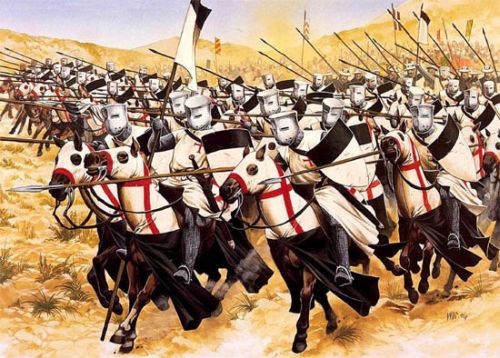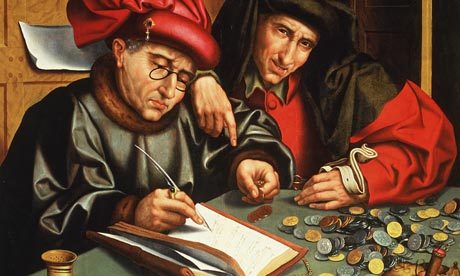The Knights Templar — Warrior Monks, Warrior BankersDuring the Middle Ages the Knights Templar
The Knights Templar — Warrior Monks, Warrior BankersDuring the Middle Ages the Knights Templar was an order of warrior monks whose duty was to defend Christendom, defend the Holy Land, and to protect Christians on pilgrimage. Today due to their popularity in the media, the Knights Templar are perhaps the most well known knightly orders of the Middle Ages, while at the same time the most misunderstood. Often modern depictions of the Templars is that of mystery, mysticism, and intrigue, as authors such as Dan Brown and History Channel/Discovery Channel documentaries speculate that they were the keepers of dangerous secrets and powerful relics. Others depict the Templars as Medieval super soldiers who hacked apart infidels without mercy. Today there is one major aspect of the Templars which is seldom mentioned and rarely discussed. While many Templars devoted their lives as holy warriors who defended the faith, the vast majority of those in the Order were not soldiers, but bankers.Originally the Knights Templar was an order of penniless monks who lived a life of poverty and humility. Officially called “The Poor Fellow Soldiers of Christ and the Temple of Solomon” the Templars would ironically become the wealthiest organization in all of Europe. It all started with the First Crusade (1096 – 1099) when Jerusalem was captured by the Crusaders. In 1129 a group of eight influential knights found the Templar Order and set up headquarters at the Temple Mount in Jerusalem with the goal of protection Christians on pilgrimage to the Holy Land. As the Templars won victory after victory against Muslim armies, their influence and power grew until the Order numbered in the tens of thousands with enclaves all over Europe and the Middle East. As the Templars became an established organization they began to offer special financial services to the pilgrims they swore to defend. Often a knight, noble, or monarch could be gone for years while on Crusade. While gone, many of Europe’s elite began to hire the Templars to protect and manage their finances while absent. As the Templars began to make a nice hunk of cash from their dealings, the Templar Order began to transform from an organization of “Poor Soldiers of Christ” to the wealthiest financial institution in Christendom.One of the Templars most innovative services was the issuance of “bills of credit”. Say there was a French Crusader who had become fabulously wealthy crusading in the Holy Land. It was time to return home, but there was the issue of transporting his wealth back home to France. After all, it would be very difficult to travel thousands of miles while carrying a heavy bag full of gold and silver, and he was at risk of being robbed as the journey home was rife with bandits, outlaws, and highwaymen. One way the Crusader could protect his money was to get a bill of credit from the Knights Templars. He simply deposited his money in the treasury at the Templar’s headquarters in Jerusalem, where they drew up a bill which included the amount deposited. When the Crusader returned home to France, he simply presented the bill to the Templar headquarters in Paris where he could withdraw his money on demand. At the height of Templar power the Order controlled over 800 castles, forts, and monasteries, all which served as bank branches where customers could deposit and withdraw their cash. Often, Templar clients could trade their bills of credit or right their own bills of credit based upon the wealth they had in their account. In essence, the Templars had invented one of the earliest forms of the checking account.As the Templar Organization grew, so too did its financial services. The Templars grew especially wealthy by offering mortgages and loans. At the time charging interest was illegal and a sin (called the sin of usury), but the Templars managed to skirt the law by reasoning that they were not charging interest, but charging rent for the goods and property purchased with the money they loaned. The Templars also invested heavily in business and trade, at one point even buying an entire merchant fleet of their own. At the height of their power the Knights Templars numbered over 20,000 members. However, ironically by that time the vast majority of the “Poor Soldiers of Christ” were actually powerful bankers, financiers, accountants, and businessmen rather than poor soldiers.In the 14th century, with their popularity waning as the Crusades drew to a close, the business practices of the Templars became their biggest liability. Pretty much everyone in Europe owed the Templars money, as the order had transformed from a group of warrior monks, to wealthy bankers, to predatory lenders and legalized loansharks. Many who had borrowed from the Templars were so heavily indebted they could not pay back and were in near default. One such person was King Philip IV of France, who was so deeply indebted due to wars with England that his monarchy teetered on the brink of collapse. Taking advantage of rumors that the Templars were heretics and devil worshippers who practiced secret ceremonies, King Philip pressured Pope Clement V (who was also disgruntled with the Templars) to issue a Papal Bull ordering all of Europe’s monarchs to arrest Templar members. Hundreds were rounded up, tortured into confessing to heresy, and burned at the stake. The rest melted away or were absorbed by other religious orders.While the Knights Templar are gone, the legacy of their Order is still with us today, as the banking practices they pioneered make up the framework for modern finance today. -- source link
Tumblr Blog : peashooter85.tumblr.com
#history#knights templars#crusade#middle ages#banking#finanace#money#economics#wealth#knights

